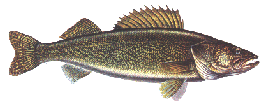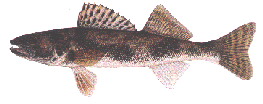
Walleye

In the early 1900's, the walleye presence in the rivers was rare and soon disappeared. It has only been since the fish were stocked in reservoirs that they have become more common. A member of the perch family, walleye are named for the glassy-eyed stare they exhibit. The spiny dorsal fin has a distinct dark blotch at its rear base. They are particularly popular with reservoir fishermen, both for the challenge in finding and catching them consistently and for their delicious meat. Most walleye are caught in April, May and early June, when they move onto the reservoir flats to feed. To catch, try trolling crankbaits or drift jigs with live bait. Walleye have prospered in many states, but they are prone to wash out in reservoirs that fluctuate in the spring.

Sauger are more common in the Missouri River Basin area. They are more at home in large turbid rivers. Sauger resembles the walleye, but they are generally smaller and have distinct blotches on the side. The dorsal fin is colorless with black spots. Their cheeks are scaled, while the walleye's are usually smooth. Sauger have been recently stocked into several reservoirs where walleye populations could not be sustained because high flow-through. The Sauger appears to be less prone to washout. Like the walleye, they are a great sportfish with delicious tasting meat.

The saugeye is a hybrid made by crossing a sauger and walleye. Like other hybrids, the saugeye is hardy ants fast. It shows the promise of filling a niche in lakes where walleye have not done well, especially in small impoundments. The saugeye resembles both parents with a spotted dorsal fin that also has a blotch at the rear base, distinct blotching on the sides and has a scaled cheek. The saugeye has only been stocked since 1990.